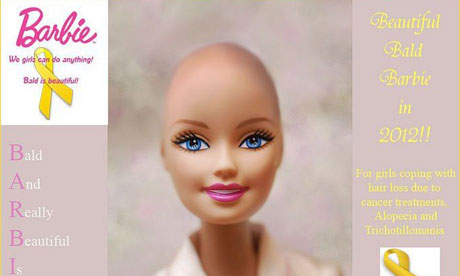
Since its debut in 1959, the Barbie doll has proved to be 11.5in of pure controversy. Inspired by a German doll, Bild Lilli, which was in turn based on a racy cartoon, it has been accused of promoting an inappropriately sexual look, stupidity (1992's Teen Talk Barbie parroted "Math class is tough!"), and, most pointedly, an unhealthy body image. Researchers in Finland once calculated that if Barbie was a real woman she'd be too thin to menstruate.
So it's unusual to see Barbie cast as a tool to boost girls' confidence. But that is part of the idea behind the moving Facebook campaign that grew and grew last week, asking Mattel to create a bald Barbie. It was started by friends Jane Bingham and Rebecca Sypin, after Sypin's daughter, Kin Inich, and Bingham herself lost their hair during cancer treatment. The campaigners suggest a "Bald and Beautiful Barbie" will help young girls "who suffer from hair loss due to cancer treatments, alopecia or trichotillomania".
Their campaign comes soon after another, in Columbus, Georgia, in which an African-American natural hair group gave makeovers to black Barbie dolls, many of which have long, straight hair. The plan was to use pipe cleaners and boiling water to give the dolls curly hair, before handing them out to show girls the beauty of their natural style.
In keeping with Barbie's controversial history, some have disputed these campaigns, on the basis that even if you change the doll's hair, she still presents a terrible body image, the ultimate damaging western ideal. It is an age-old feminist question. Do you work with what the mainstream offers, and subvert it as positively as possible? Or try to keep girls away from Barbie altogether? With billions of dolls now sold, that last aim is just as tricky as ever.

